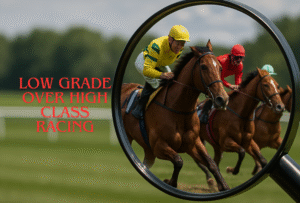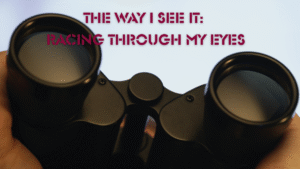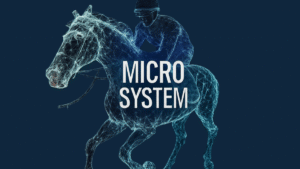Recent Horse Racing Articles

Place Only Betting In Horse Racing
Why Place-Only Betting In Horse Racing Beats Each-Way When You Fancy a Horse to Place, Not Win If you’re still
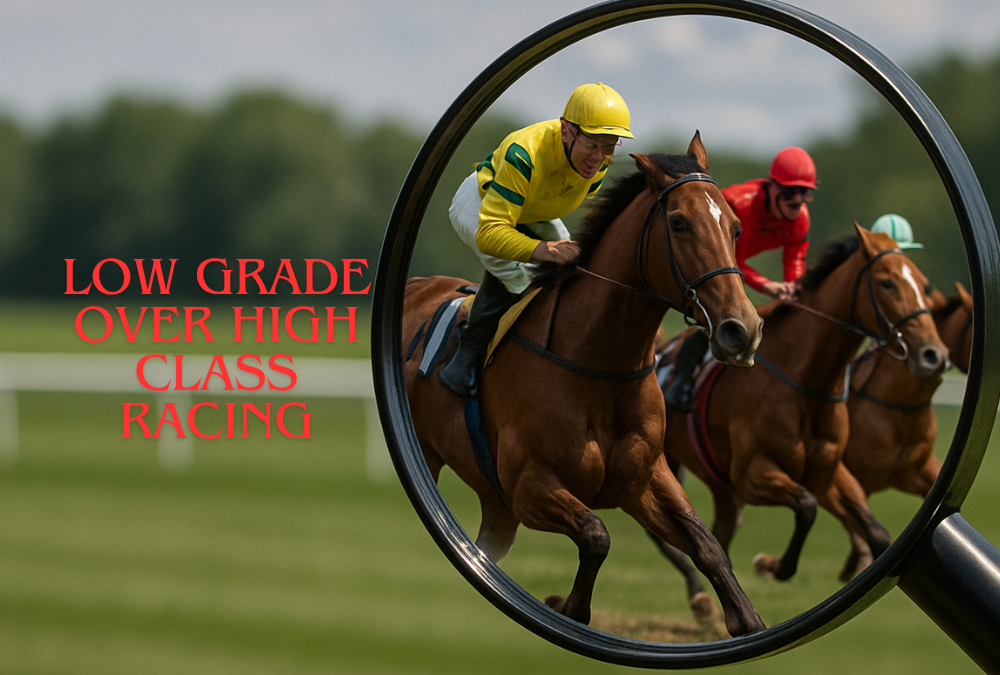
Why I focus Mostly On Lower Grade Horse Racing Particularly The All Weather Horse Racing
Why I Focus on Lower Grade Horse Racing — Especially the All Weather Scene Most people want the big races.

How I see Horse Racing betting, My views on the form & what makes me tick .
“I Don’t Love Racing for Racing’s Sake — And That’s OK” In this post, I want to explain what really

Bet £10 Get £30 3x £10 Bets
claim Now
Bet £10 Get £30 FREE BETS
Claim Now
Bet £10 Get £20 FREE BET
Claim Now
Bet £10 Get £50 In Multiples
Claim Now
Bet £10 Get £50 In Multiples
Claim Now




AI in Horse Racing
There’s a lot of buzz around AI in horse racing lately — some of it overhyped, some of it misunderstood. So let me be clear: I don’t believe AI can predict winners on its own, and I don’t think it ever should replace proper race reading. But I do believe AI has a place in racing — not as a tipster, but as a powerful tool for analysis.
I’ve built my own system around this principle. It’s not magic — it’s just structured analysis made faster and sharper with machine learning. My AI model doesn’t tell me who to back. It tells me which horses are running in conditions they’re most suited to, based on deep profiling and past data. Then I do the rest.
This page explains exactly how I use AI, what I believe its true role is, and why I think it’s one of the smartest ways to enhance your edge without losing the human touch.
That said, there’s a limit to what AI can realistically achieve in this sport. You could, in theory, build an AI model for top-end racing — where horses generally run to form and the data is cleaner. But then you have to ask: what’s the point? In those races, the key details are usually already obvious to the trained eye. The real challenge lies lower down the grades, where form is inconsistent and context matters.
And that’s where AI tends to struggle. It doesn’t think — it calculates. It’s black and white. It doesn’t know when one factor outweighs another or how to interpret intent, pace bias, or how a jockey switch might impact performance. Unless it’s trained with extreme care and a massive volume of contextual data, it ends up as nothing more than a statistical model. And at that point, you’re just recreating what’s already available on platforms like Proform — a ratings system built from stats, not insight.
Plus, horse racing has one thing most AI systems aren’t built to handle — people. Trainers make decisions that defy logic. Jockeys change tactics mid-race. Owners might have input that shifts a horse’s campaign. And let’s not forget: horses aren’t machines — they have their own brains, moods, and motivations. You can model patterns all day long, but once the stalls open, anything can happen.
What AI Can Do in Horse Racing (and Why I Use It)
While I’ve made it clear that AI isn’t a silver bullet for horse racing, it would be wrong to ignore just how powerful it can be when used properly. AI might not understand the sport the way a seasoned analyst does, but what it can do — it does exceptionally well.
Pattern Recognition at Scale
One of AI’s biggest strengths is its ability to detect patterns across large data sets. Where a person might need an hour to break down a horse’s form across different tracks, ground types, distances, jockeys, and running styles, an AI model can find those patterns instantly. It does this with consistency, and it never overlooks something due to fatigue or bias.
Speed and Efficiency
Detailed form analysis takes time — sometimes hours per race if you do it thoroughly. AI can reduce that to seconds. Once trained properly, it can process thousands of data points and immediately tell you which horses are running in conditions they’re most likely to perform in, based on historical patterns. That’s not about tipping — that’s about saving time and improving the quality of your analysis.
Reliable Filtering
AI works well as a filter. It won’t give you the final answer, but it will narrow down the field logically. It can highlight:
Horses that are well-handicapped based on past ratings trends
Horses that underperform at today’s course type
Runners with ideal pace setups or track biases in their favour
This gives you a shortlist that you can then analyse properly — without wasting time on horses that don’t belong.
Consistency
Humans aren’t always consistent. We’re influenced by recent results, emotions, even personal bias. AI is immune to that. It treats every race, horse, and dataset with the same logic. That kind of consistency can be extremely valuable, especially over long-term analysis.
Potential for Deeper Real-Time Use
While I don’t currently use AI for real-time adaptation, the potential is there. For example, an AI model could one day react to live going changes, update pace expectations on the fly, or even identify developing track biases throughout the card. With the right inputs, it could evolve into a tool that supports both pre-race and in-race decision-making.
My Own Application
I’ve trained my AI model to reflect exactly how I approach horse profiling — not just in isolation, but in the context of the race as a whole. It understands the factors I value most: course suitability, distance, pace, ground preferences, recent performance patterns, and how those align with today’s conditions. This isn’t some generic stats tool — it’s custom-built to mirror my way of breaking down a race.
In its bare form, what it produces looks like this:
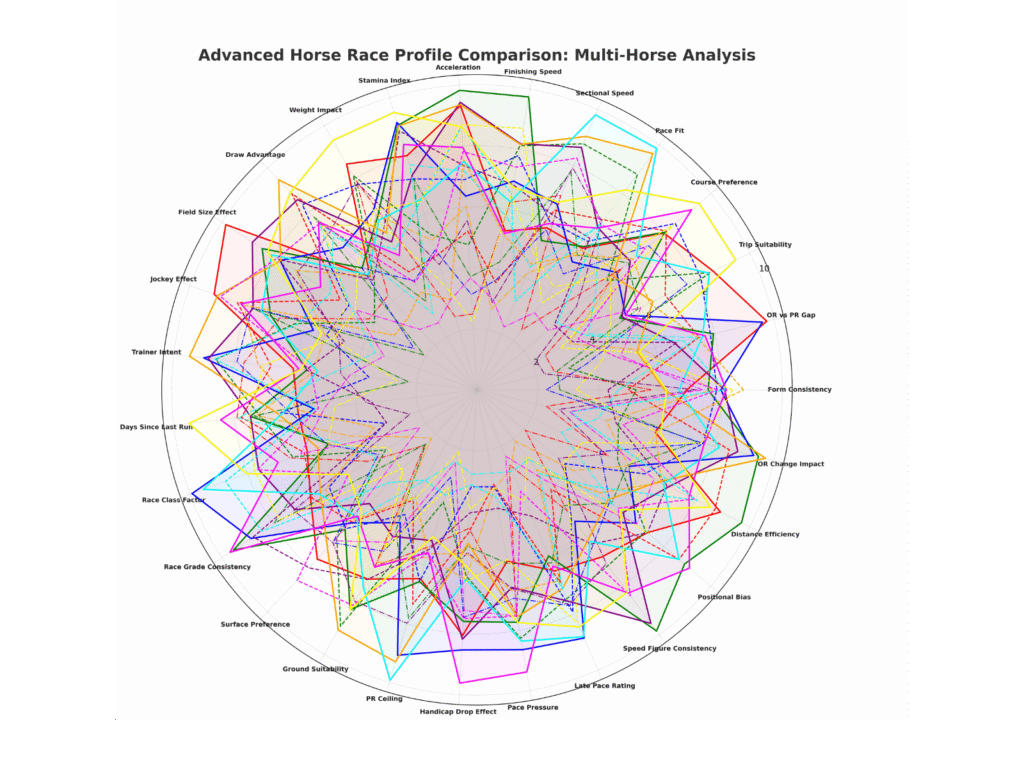
This is a multi-horse radar chart that compares every runner in a race across the exact variables I care about. These include things like:
Race Fit and Trip Suitability
OR vs PR Gap and Change Impact
Course and Surface Preference
Stamina and Finishing Speed
Positional Bias and Draw Advantage
Jockey and Trainer Impact
Days Since Run and Race Grade Consistency
PR Ceiling, Handicap Drop Effect, and many more
Each coloured line represents a different horse. The further a line extends outward on a given axis, the more that runner scores for that factor. So in one visual, I can instantly see which horses tick the most boxes, and which are exposed when tested against today’s setup.
It may look complicated at first glance, but this is just the base layer. I can take it a step further and drill into each horse individually if I want to. But the key point is this — the AI has already broken down every horse across dozens of variables in a matter of seconds. Doing that manually would have taken me hours. That’s the power of using AI the right way — not to make guesses, but to handle the heavy lifting and let me get straight to the analysis that matters.
The AI doesn’t give me tips — it gives me context. I still make the final call, but this system highlights suitability based on how I read races, with no shortcuts and no fluff. It saves time, removes bias, and gives me a clean head start on every race.
What AI Can’t Do – And Why That’s the Point
Alongside my main analysis model, I also use AI to profile each horse specifically against today’s race setup — including ground, trip, class, and the expected pace. This is where AI really adds value. It can instantly scan the entire field and highlight horses that are either well-suited or poorly placed based on current conditions. That saves hours and gives me a sharper focus going into a race.
That said, not everything can be handed over to AI. Sectionals, for example, I still do manually. They’re highly subjective, and AI isn’t designed to interpret grey areas well. It works best when measuring facts, not opinions. And that’s fine — because when you treat AI for what it is, rather than what people hype it up to be, it becomes a reliable and incredibly efficient part of the process.
It’s not here to replace humans — and it never will. There’s too much external human input in racing: trainers have their own plans, jockeys make split-second decisions, pace can collapse or explode depending on how others ride, and horses themselves have off days, moods, and minds of their own. No AI can model that accurately.
But if you use AI for the heavy lifting, for the repetitive tasks, and for the objective profiling — it absolutely has a place. It gives you the groundwork, the structure, and the shortlist. That way, you spend less time grinding through form and more time focusing on the things AI can’t do — judgment, interpretation, and feel for the game.
To summarise: AI in horse racing isn’t about predictions — it’s about process. Use it to your advantage, train it well, and let it free you up to do the part of the job only a human can do properly.




